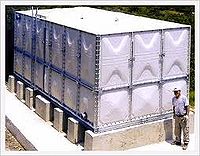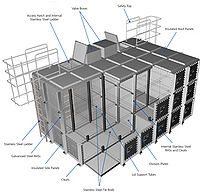GRP Tanks
GRP Tanks (Glass reinforced plastic tanks) have a variety of applications and are very common in the chemical and food and drink industries for storing a wide range of materials, some of which are classified as hazardous. Many GRP vessels and tanks are produced annually and the vast majority perform satisfactorily. However, a number have failed in service, with a proportion of these failures being catastrophic. Even in situations where the substances contained are not themselves hazardous, the consequences of a catastrophic failure may be serious. To reduce the risk of such failures, you should be aware of what can go wrong and – more importantly – how to avoid it.
Common Materials Used
Improvements in resin technology over the last decade have resulted in a range of case histories of the successful use of GRP in hostile environments. Manufacturers of GRP tanks and vessels have access to published data to inform the choice of resin for a particular duty and they may also discuss resin selection directly with the resin supplier. Resin systems can achieve different maximum operating temperatures, so with careful selection of liner and resin system, GRP can offer excellent corrosion resistance to a wide range of fluids and gases at ambient temperatures and at higher temperatures, subject to documented service experience or testing (typically up to a maximum of 50°C, but beyond that in certain circumstances).
Problems can occur because some chemicals, particularly oxidising acids, alkalis and organic solvents, have adverse effects on GRP. Once the liner and resin system have been selected to suit the particular operating environment, the unit should perform satisfactorily. However, if the original design duty is subsequently changed or exceeded then new degradation mechanisms may occur.
It is a requirement of the design standards that there is an adequate margin between the maximum operating temperature the vessel will experience (the design temperature), and the temperature at which the strength of the resin deteriorates beyond acceptable limits (the heat deflection or distortion temperature). Depending on the design standard and temperature, this margin is at least 20°C and can be as much as 40°C. Correct selection of resin should ensure that the unit performs satisfactorily at the specified temperature. However, if the operating temperature is elevated above the resin design limit, eg due to a process upset, materials which are themselves innocuous may have adverse effects on GRP.
Pressure Systems Safety Regulations 2000 (PSSR)
PSSR 2000 will apply to GRP vessels containing a relevant fluid. Guidance on these Regulations is available in the Approved Code of Practice, L122.9 Duties include producing a suitable written scheme of examination (WSE) for the purposes of preventing danger from those parts of the pressure system included in the scheme, such as an uncontrolled release of stored energy. A competent person, as defined in the Regulations, must write or certify the WSE as suitable for this purpose.
Operation
GRP tanks and vessels should be operated within defined safe operating limits, based on the original design or a revised duty verified by a competent person. Where a tank or vessel is subjected to conditions outside the allowable operating limits, eg during a process upset, which may raise the temperature above the maximum allowable limit, this should trigger a review of the possible effects arising from the deviation to verify the continuing integrity of the item.
GRP Sectional Tanks
Divisions
Fibreglass sectional tanks can be divided into compartments with stainless steel internal RHSs and cleats. Any divided section of a tank should not remain empty for more than 7 days to preserve the torque setting of the structure.
Insulation
Pre-insulated panels use zero ozone depletion polyurethane foam which is then covered with a waterproof skin. Phenolic foam insulation is also available to special order.
Access Hatches
All fibreglass tanks come with a raised access hatch which is secured by 4 stainless steel fixings with a special finger friendly top to enable the access hatch to be opened. To complete the requirement a seal is located on the underside of the access. This seals the top from the ingress of dirt and moisture. The access can be modified to be hinged and lockable, if required.
Video

